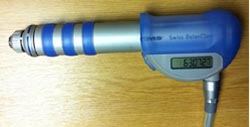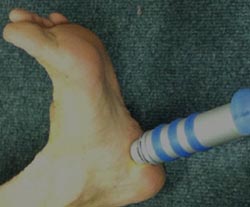What is extracorporeal shock wave lithotripsy (ESWT)?
It is literally a form of shock waves applied to the outside of the body (extracorporeal). Lithotripsy has been used for a long time to break up kidney stones. More recently it has been used to treat various elbow, shoulder and ankle problems.
 The shockwaves are characterised by an energy transmission with a sharp rise time in positive pressure with a rapid drop into negative pressure and then return to neutral within a millisecond. The negative pressure causes the water molecules to implode, thus creating a water jet, the water jet is released at speeds from 100-800m/s these water jets that create micro trauma at the site and hence an inflammatory effect, this then stimulates a healing response.
The shockwaves are characterised by an energy transmission with a sharp rise time in positive pressure with a rapid drop into negative pressure and then return to neutral within a millisecond. The negative pressure causes the water molecules to implode, thus creating a water jet, the water jet is released at speeds from 100-800m/s these water jets that create micro trauma at the site and hence an inflammatory effect, this then stimulates a healing response.
As this is a relatively new procedure we are not sure of the exact chances of success, but the early studies are encouraging. More importantly the risks appear to be very low. A very large multicentre study (ASSERT) has been set up to review the results of treatment, Mr Jowett is one of the investigators in this study.
Most insurance companies will cover this treatment if it is registered as part of the study and performed by one of the registered investigators.
 What does the treatment involve?
What does the treatment involve?
ESWT is an outpatient treatment, it involves the application of a probe (see photo, right) to the affected area; a pre-determined number of shock waves then emanate from the probe through the affected area at specific frequency and pressure (the pressure may be adjusted mid way through the treatment).
The treatment takes approximately 5 minutes. The process is repeated every week for three to five weeks.
Does it hurt?
During the treatment you may experience mild discomfort; similarly the evening after the treatment you may experience some discomfort, his should gradually settle.
How long does it take to work?
The current evidence suggests that the results are usually evident at 6 weeks.
What are the risks?
The risks are very small, failure to settle your pain being the main one. If the treatment is for the Achilles tendinopathy: rupture has been reported after treatment, but it is not possible to be sure that this is directly related to the treatment.
